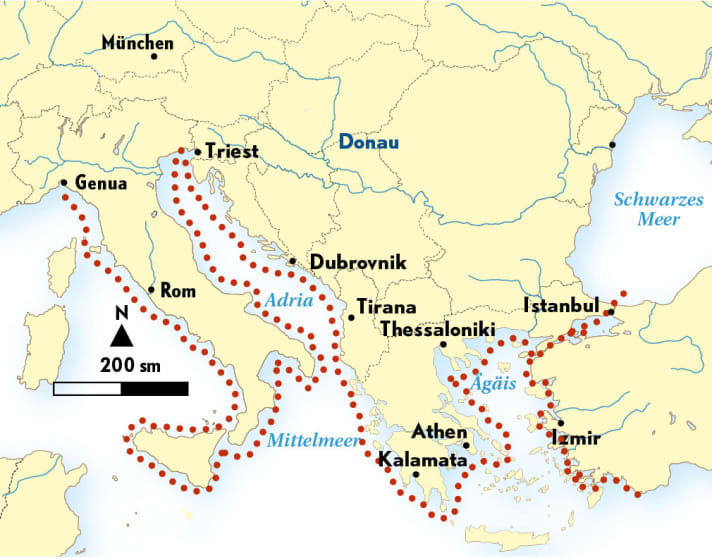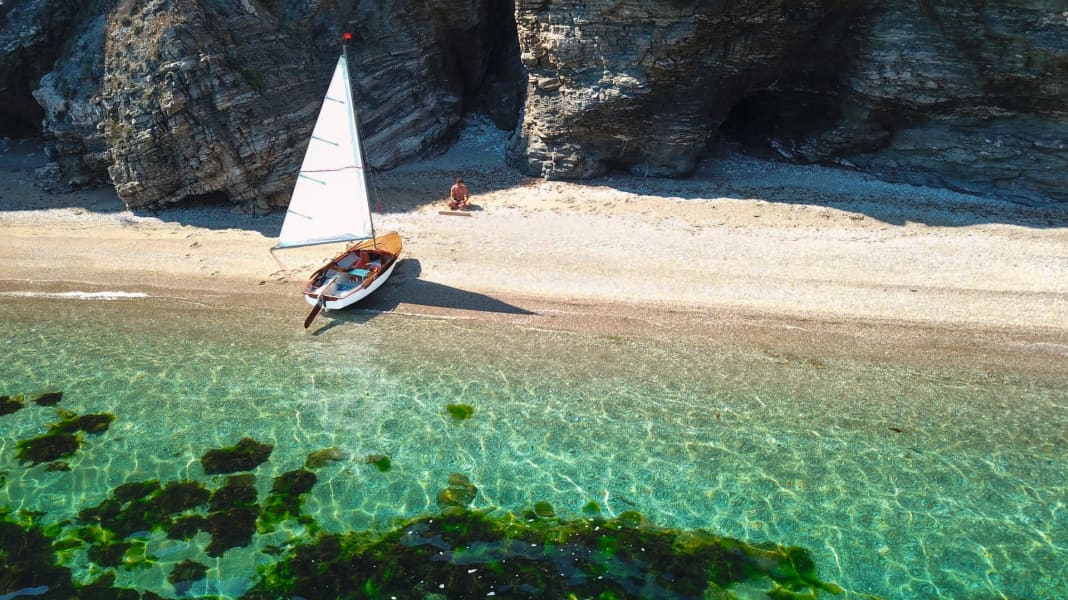
Freedom is to look for a point on the map and, without knowing this place, simply set off there. That's how I discovered the village of Pasamandira, from where a small river leads into the Black Sea, very close to the northern entrance to the Bosporus. That's where I take a dinghy that I have extensively restored at home.
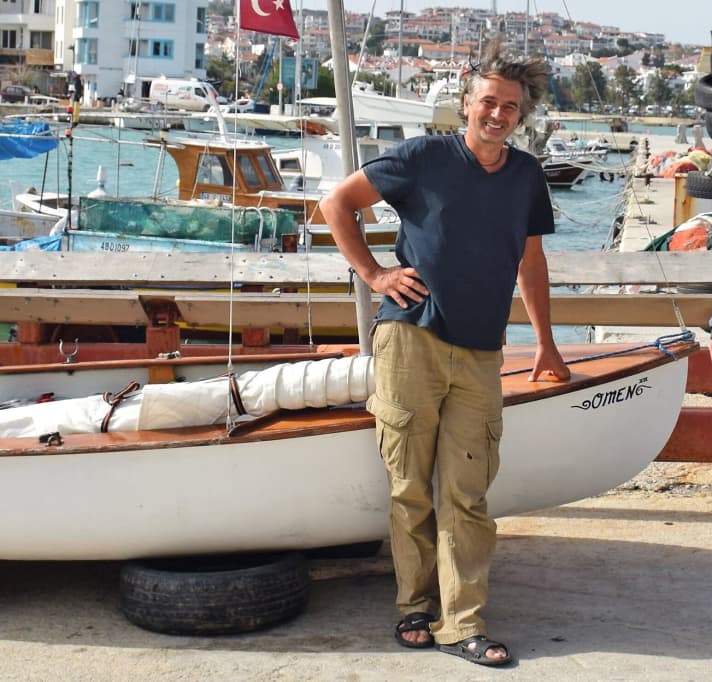
The choice of location is not entirely arbitrary. I want to continue my coastal journey from Pasamandira. It has already taken me in another dinghy first around Italy and then with a Seascape 18 from Trieste along the entire eastern Adriatic southwards and via Greece to Istanbul and the Bosporus. A continuous course of over 6,000 nautical miles, always close to land and missing almost no major bay.
This time my boat is a 55-year-old, 3.70 metre small and 90 kilogram Zef dinghy. Why? Because the next boat had to be even smaller! So small and light that I can pull it out of the water alone on a beach. That gives me maximum independence and an additional safety benefit.
The river in Pasamandira turns out to be a green, overgrown body of water surrounded by beautiful nature when I arrive in autumn 2017. I almost can't believe it myself when I push off into this unknown river at noon the next day: You want to travel several thousand miles from here? I row off happily, have to lower the mast once to get under a bare, low-hanging power cable, and after a few hours of rowing I reach the Black Sea. Enough for a start. I pull my boat onto a large, deserted sandy beach and take a deep breath. A new adventure has begun.

It soon gets off to a strange start. I don't stay alone on my private beach for long. A small wedding party appears. The newly married Muslim couple immediately use my little "omen" as a romantic backdrop for hours of photos - until sunset. As a thank you, they offer me a small wooden hut above the beach to spend the night. The women bring me food and even an electric blanket out of concern that I might freeze.
I will encounter such unexpected hospitality many more times during my trip to Turkey. As I fall asleep in the hut overlooking the beach and my little boat, I think to myself: "It would have been impossible to predict the outcome of this day. But even more important is not wanting to foresee it at all! After all, that is basically the prerequisite for the real experience, the real adventure."
You are not allowed to sail in the Bosporus. But that can't possibly apply to me. My little dinghy is certainly not subject to any rules that have been laid down for yachts. So I sail along the partly historic houses and the winding, 20-mile-long coastline of the strait in beautiful sunshine and a light tailwind. I have a smile on my face the whole time, I feel so carefree. Towards the southern end of the Bosphorus, the houses on the shore become denser and skyscrapers move into view to the right and left. The 15-million metropolis of Istanbul announces itself.
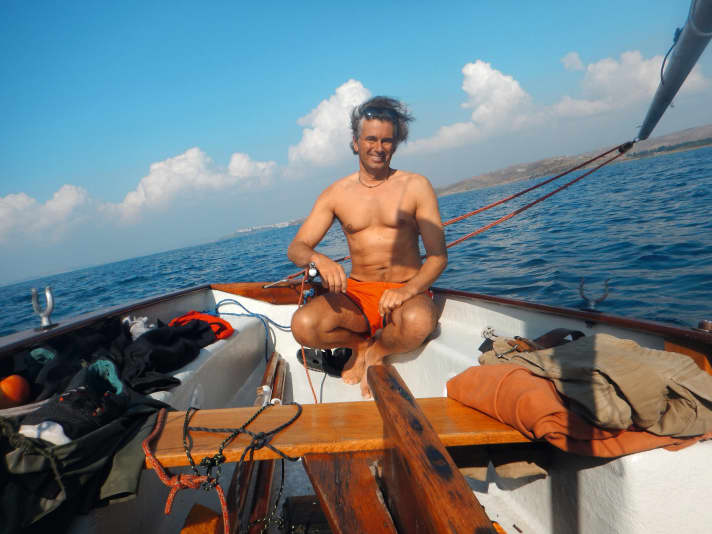
Here I cross the wake of my Seascape 18, on which I had spent some time in Istanbul the year before. It's amazing how quickly the huge city with the towers of Hagia Sophia, the Blue Mosque and Topkapi Palace can be left behind, even if you're sailing a small dinghy like me. From now on, I'm travelling again in this carefree, detached state of freedom. From now on, I follow the coastline on the other side, the Asian side. How far? Very, very far! But without thinking about a fixed destination or a timetable, without much planning or equipment.
"The Sea of Marmara is hard, grey, windy and cold," I wrote in my logbook when I cruised towards Istanbul on the Seascape in November and December. Thanks to ideal conditions, this time I get to know the lonely and sometimes very poor-looking coast on the other side of the Sea of Marmara. In the villages, cows are herded through the dirt roads where children play and a travelling salesman sells socks from his car. And where the muezzin croaks in painful dissonance from the mosque loudspeaker.
I'm sitting in a teahouse with a fisherman, chatting to him in Italian, when the singer, whose intonation is off, sits down with us. "Oh, it was you," I say incredulously, "who just called for prayers?" "Yes," my counterpart replies proudly, his teeth wobbling menacingly. "We always take turns here in the village. Everyone gets a turn to sing!"
Even in villages like this, where there is usually no restaurant or anything similar, I am asked if I am hungry and a fresh fish is put on the grill at the harbour, some salt and lemon are served with a salad. Nowhere do I have to worry about my boat or my belongings. I leave everything unlocked, even if I'm exploring the country for a long time.
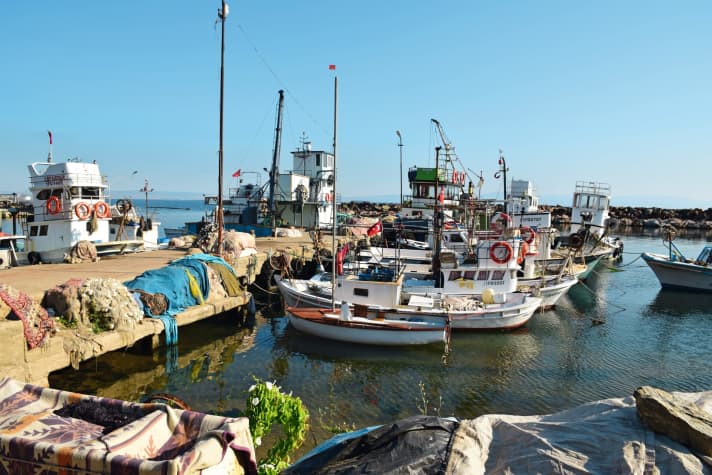
And as is so often the case, it is the people who live in the most modest of circumstances who are the warmest and most generous. "Where do you sleep?" - "In the boat." - "No, you're welcome to spend the night here." A tiny cottage, spotlessly clean, a bed and a small window with a view of the tiny fishing harbour.
When I have already left the Sea of Marmara and the lively university town of Çannakale lies astern, a long-awaited highlight of my journey is approaching: 13 years after my departure from Genoa, Troy now lies before me at the exit of the Dardanelles. The coast here is a wild, flat piece of land that has been washed up by the Scamander and other rivers over the past 3,000 years. Ancient Troy, on the castle hill that Schliemann discovered in 1873, now lies a few kilometres behind the coast.
I sail the dinghy up the Skamander, despite the thick reeds and trees towering far above the river. Only when the water is only ankle-deep do I climb ashore. There is not a soul to be seen in the scorching heat. And yet: this is where Achilles and Hector are said to have fought and where the legends of the Iliad are set.
For a sailor, the strategic importance of Troy is obvious. It is not without pride that I have managed to master the current-rich straits, the Bosporus and the Dardanelles without any engine power at all. But this requires a boat with good upwind characteristics. The ancient ships did not have these. They had to wait until the Meltemi stopped blowing and a southerly wind made it possible to pass through the Dardanelles against the current, which was blowing at up to four knots. And it was precisely this bay off Troy that was ideal for waiting for a favourable southerly wind.
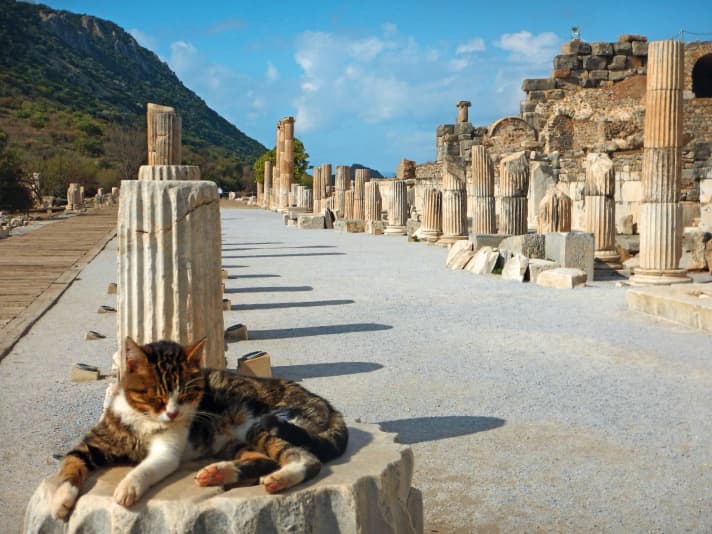
I visit the excavations several times. Then I finally leave the Hellespont in a strong wind, round the cape at Kumkale and am in the Aegean!
My equipment on board is minimal. Everything is packed watertight and tied up. Plus anchor, bailer, regatta waistcoat, maps or satellite images of the coastline, a mobile phone for weather forecasts, not for navigation. No engine, no electrics, no instruments, no GPS, not even a compass. Instead, eyes, ears, nose, instinct and experience. Renunciation becomes a pleasure when it is voluntary. I have owned numerous boats and yachts in the past, have crossed the Atlantic several times on my own keel, am a qualified boat builder and, as a professional skipper, am very familiar with sailing with a plotter, hot shower, air conditioning and all the bells and whistles on board. Doing without all this ballast now puts an almost boyish smile on my face.
Every day is determined by the weather and the course of the coast. I set off in the morning without knowing how far I will get. If I discover a beautiful or interesting place, I go ashore. It's incredible how many deserted and inaccessible beaches you discover between the often spectacular cliffs of the steep coasts. I almost have dream beach inflation - and yet I'm always tempted to land where hardly any other boat can get to.
In the evening, I usually stop at a village or a small harbour. I often sleep in solitude under the stars, make a fire and feel like a trapper in the Wild West who moves on every day. If I am invited, I make new contacts for the following days almost every day, as soon as it becomes clear that I am only travelling in this motorless little boat. It's amazing how well connected the Turkish sailors are. They always say, if you get there or thereabouts, get in touch with my friend who will help you.
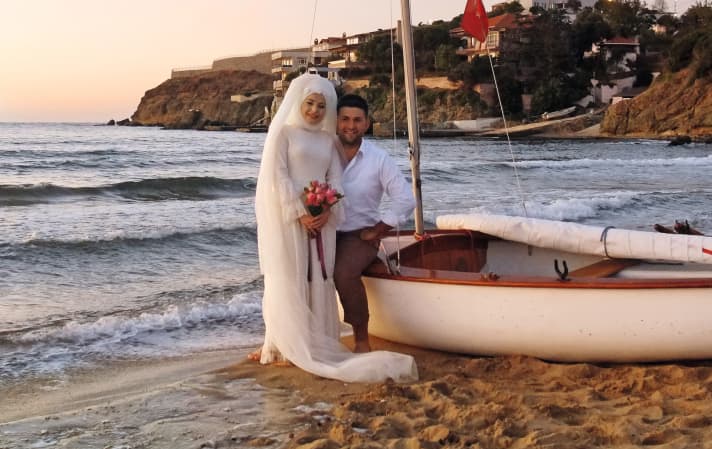
This is how I get to know Ilhan. He tells me: "We are over 3,000 sailing friends from here to the very east of Anatolia. If you ever have any difficulties, give me a call, we'll get you through."
Days, weeks, months and - due to the pandemic - even years pass by. Interrupted by sometimes shorter, sometimes longer stays at home, I wind my way along the Turkish west coast section by section. It winds from north to south in large bays, off which the Greek islands are often close enough to touch: Lesbos, Chios, Samos, Kos, Symi, Rhodes and, in the far south, the small island of Kastellorizo. While the islands are mostly barren, the Turkish mainland is green and forested. However, one rocky headland after another juts out into the sea. Following this coastline means sailing around one cape after another.
The prevailing Meltemi helps. It blows from north to north-east in both summer and winter. As a sailor, you know about the turbulence that a cape brings with it. If mountain ridges over 1,000 metres high rise up close to the coast, the cape effects are particularly strong.

In January this year, I set off south of Kusadasi early in the morning in cold, strong winds and sunshine. The large Dilek Peninsula lies before me, a nature reserve with no population, apart from the numerous wild boars and other animal inhabitants. The wind pushes wonderfully into the reefed main and everything is under control. It becomes increasingly narrow between the mainland and the island of Samos. My "Omen" surfs through the Strait of Mykale. Here, Turks and Greeks can almost wave to each other.
Unfortunately, the wind picks up in the narrows. I have to drop off and master the upcoming jibe in six Beaufort. It goes well. And as if as a reward, the cape is immediately followed by marvellous beaches and bays. I take a break there, sit down in a sheltered corner by the rocks and let the sun warm my face. When I leave this refuge again, there are about five miles of rocky cliffs in front of me. Ridiculous, you might think, but not at all! The wind has picked up further and I can see the crests of the waves on my starboard side at a distance of about a nautical mile: all white! The wind is blowing steadily again after it has overcome the mountain massif, now with at least seven Beaufort.
The Mycale Mountains rise up on the port side. Gusts fall down. They form circular eddies on the water, whip it into white spray, chase along like mini tornadoes for a few hundred metres and then dissipate as quickly as they formed. When and in which direction such eddies occur is unpredictable. "Far too dangerous to sail here," I think to myself, gather up the cloth, stow everything with as little surface area exposed to the wind as possible and decide to row.

If a gust catches me, it might blow me back a bit, but with enough stamina, the five nautical miles won't be a problem - I've already rowed quite different distances. But then it happens: an eddy rushes towards me, grabs the boat and flips it over so quickly that all I can think is: "No way!" I'm already swimming in the water.
Luckily, I had trained for just such situations and prepared myself and the dinghy accordingly. I quickly righted the "Omen" again, drained the water with the tied-up bailer and collected the tied-up oars and other equipment.
Then I row to the steep coast, where I can drop anchor in a cut between the rocks and secure the boat with a land fortress. I climb ashore, look for driftwood, light a fire and set up a bivouac like a mountaineer in the cliff face, because there is only one place in the surrounding towering rocks where you can lie horizontally. "It's actually beautiful," I think to myself, cooking a simple pasta dish with olives and sheep's cheese as the moon rises behind me over Mount Mykele and night falls.
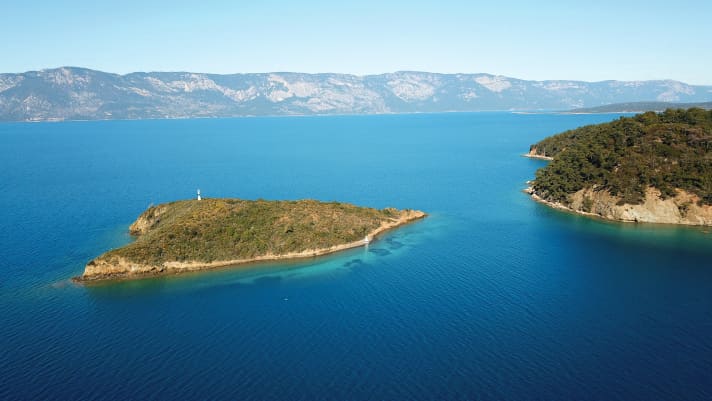
Hardships quickly turn into a feeling of happiness, especially if you know how to make yourself comfortable despite the inhospitable conditions. You don't have to go to such radical lengths as I do. But the basic idea remains: With less emphasis on technique, equipment and fixed planning, the intensity of the sailing and the experience increases. But be warned of the gusts that lurk in the supposed protection of high mountains.
The contrast is marvellous as I enter the plain of the Great Meander and sail along endless sandbanks. Pink flamingos stalk across the sand and take to the air when my little sailing boat gets too close. This is undoubtedly the start of the most scenic stretch of coastline I have had the pleasure of exploring. But it is still long before the sailing season. Even though the sun is already gloriously warm during the day, the thermometer still drops to zero degrees at night. Pushing the boat into the water early in the morning at sunrise in the icy wind in order to sail requires a bit of sporting spirit.
When I arrive in Bodrum in the pouring rain, my friend Ilhan is already waiting for me. From a Lagoon 620, Ali tells me to go alongside: "Hello, welcome!" I transfer from my dinghy to the 20-metre luxury catamaran. The contrast could hardly be greater. "Would you like a coffee?" We sit on soft cushions in the huge, heated saloon, surrounded by polished stainless steel and striking indoor plants. Behind the panoramic windows, the clicker in the masthead of my dinghy rocks almost at eye level.
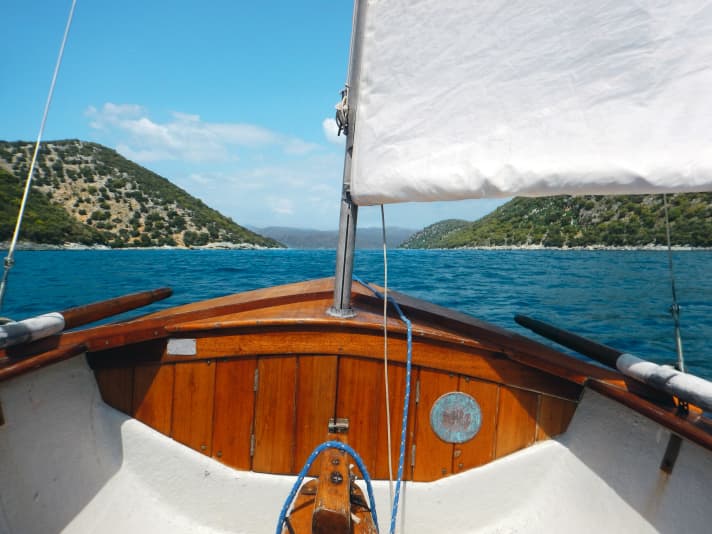
"When you get to the next cape, on the Datça peninsula, you have to visit my farm," says Ali. "You can stay as long as you like. We produce olive oil, soap and wine there - all organic."
But first lies the great Gulf of Gökova, which I sail to Akyaka at the very end. The southern coast of this bay, which cuts over a hundred kilometres deep, is particularly fantastic: lots of secluded nature, sheltered anchorages, small islands and white almond trees in bloom. I then visit Ali's farm on the cape not far from historic Knidos before reaching Datça harbour.
After Marmaris, there are already over a thousand nautical miles in the wake of my dinghy. A little later, I reach the Gulf of Fethiye. Now the number of dangerous capes is gradually decreasing. The large bay is another sailing paradise. "The light is warm from the early sun over the deep blue sea, the green islets lie in magical tranquillity in front of the bow," I write in the logbook. Pine trees reach right up to the shore, and in summer yachts and gulets are moored so close to the shore in countless small bays that often only the bow sticks out between the dense greenery.
An old man waves to me at the fishermen in the centre of Fethiye. I can moor behind his boat with a stern anchor. I immediately notice the unusual name of the boat: "Maverick". The old man surprises me even more: Ertugrul is 73 years old, lives on his simple boat, speaks English and German and tells me: "I still have over 4,000 books in a storage shed, I've always been very interested in German literature and lexicography." I stay with him for three days. He is an inexhaustible source of surprise. We talk late into the night about artists and philosophers. My encounter with him shows me once again that you have to meet everyone with an open mind.
After a long conversation, people in Turkey say goodbye: "I can't get enough of you." To which the answer is: "I don't believe a word you say." With these words, I say goodbye to Ertugrul. I sail on with my "Omen" to Kas, not far away. There I finish my last stage for the time being. I don't know when I will continue. But it will go on. I can't get enough of this great adventure.
